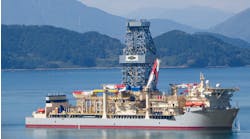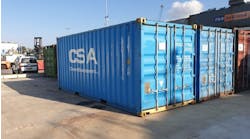Well control shifts to prevention and globalization of response
"You light them - we fight them" industry origins gone forever
William FurlowThe recent merger of Boots & Coots with International Well Control is the latest evidence the well control industry is changing - to virtual prevention of all uncontrolled events and the globalization of response resources for events when they occur.
Contributing Editor
Gone forever is the "You Light 'Em We Fight 'Em." mentality that made living legends out of Red Adair, Asger "Boots" Hansen, and Edward Owen "Coots" Matthews. The next generations sport a more formal education, sophisticated operations management software, and a "No Event" approach to the business. If the next generation has its way, fire-fighting will be a thing of the past.
The well control industry is changing in other ways as well. Traditionally based in Houston, Texas, the new emphasis of some companies is globalization. This expensive prospect means alliances are being formed and further incorporation of what was once strictly a hands-on business.
The new offices of International Well Control say more about the changing industry than an analysis of their Boots & Coots buyout. While the firefighting equipment and personnel still report to the less palatial Boots & Coots facility on N. Houston Rosslyn in Houston, the corporate offices are in the glass and granite Halliburton building, where muddy boots would seem out of place on the pile carpeting and more explicit communications would drown out the Muzak.
With paintings still leaning against walls and office supplies still in boxes, the "new" International Well Control wrestles to become comfortable with it's Halliburton alliance and Boots & Coots acquisition. The Boots & Coots deal added equipment and almost doubled the company's manpower, and the Halliburton alliance has opened a door of opportunity that IWC hopes to realize with these new assets.
Early diversification
IWC can trace its origins to Red Adair, which is to say to the beginning. Like Boots & Coots and International Well Control, IWC was formed by former Red Adair disciples who learned what there was to know, then branched out on their own. IWC was formed in 1994, after Adair retired.The Halliburton alliance in 1995 seemed like a natural fit, according to IWC president Brian Krause. Halliburton supplied pumps and other equipment used by IWC, and IWC was called out on a lot of Halliburton projects. Krause said Halliburton approached his company with the concept of "one-stop shopping". He said Halliburton liked the security of making one phone call when there was a problem.
Regardless of the severity of the situation, Halliburton would rely on IWC to handle all well control matters. The official name of this alliance is WellCall, and for IWC it did more than offer a major partner - it offered an opportunity to expand.
"We now have eyes, ears, and personnel around the clock and around the world," Krause said of the push to globalize. The close ties to Halliburton form the core of what IWC, and other industry leaders, see as the future of well control.
In the event a blow out does occur, the fact that IWC has personnel in far-reaching areas means it can respond to a blowout in a remote area quickly. "The first few minutes of these events are always critical," Krause said.
What Halliburton gets, apart from the savings on blow outs and related experiences, is an educational dividend. IWC trains Halliburton personnel on site, so they will be better able to identify potential problems and react properly when emergencies occur.
Wild Well, Cudd
While the IWC Halliburton alliance is the most dramatic illustration of the industry's new direction, it is not unique. Cudd Pressure Control and Wild Well Control, while not forming alliances, are broadening their approach to the business. Cudd also has personnel stationed in remote areas. Steve Mayo, Director of Business Development for Cudd, said this allows his company to mobilize workers and equipment from alternative locations, if traditional routes from the US are out of service.Mayo said his company has always focused on a broader approach to well control, offering coiled tubing, wireline services, and safety training as well as well control. Cudd also offers engineering services to clients. Mayo said the company has seen a greater emphasis on overseas work, which now makes up a full 70% of his business. He said the entire industry is booming along with the oil sector.
"Already this years we are at 42 jobs (The company worked a total of 104 jobs in 1996) People are having more accidents," he said.
Although Cudd does offer well control, Mayo said snubbing services are the company's real strength. This type of diversification may not be new for Cudd, but it has taken the industry by storm. The reasons are simple.
By consulting with clients on everything from well design to emergency response plans, well control companies create steady cash flow. The traditional emergency response approach was not only more expensive to undertake, but produced a feast-or-famine environment for companies which lived on earnings from one accident to the next.
This broad-based approach also is more economic for the smaller E&P companies. As independent drilling companies capture a growing percentage of the exploration market, they are looking for more reliable and cost effective approaches to well control. Very few independents can afford to fight a blowout that lasts days or weeks. The best solution all around is to target weaknesses in a program early on and work to prevent problems.
Centralized or dispersed
While everyone agrees that prevention and education are important requirements, the approach to globalization is still a point of contention. While IWC believes it has an advantage with the addition of Boots & Coots equipment and personnel to man the hot spots of the globe with trained workers and world-class equipment, Wild Well Control (WWC) says it wants to remain centrally located.Peter Atkins, manager of special projects for WWC, says his company maintains a base of personnel and equipment in Houston and is the undisputed market leader. He does not see a need to spread out equipment and personnel. Keeping equipment in Houston means he can supervise its maintenance and does not impede his response time to emergencies. The equipment is specially designed to be air mobile, Atkins said.
Atkins said WWC has seen its share of the well control market grow with the independent companies which helped establish the company. Traditionally, these were companies which did not have enough money to hire the more prestigious Boots & Coots, so WWC offered a less expensive alternative.
As the outlook of the industry changed over the past decade WWC was in a position to benefit by being a cost-effective provider. WWC, as well as IWC, and Cudd are involved in engineering as well as well control, but Atkins said WWC has taken a well control approach to firefighting from the start, preferring to prevent fires rather than put them out.
The next generation
The technical know-how of well control personnel has grown, along with that of the industry. Companies that once operated as clearly defined response businesses now are helping organize the deployment of firefighting personnel and equipment and advising companies on relief wells and prevention.Atkins said the next generation of well control legends is already on the job. These are workers with outstanding educational credentials who lack only experience. When it is time for these workers to take control, the industry should be completely converted to the prevention approach, using what IWC calls the "No Event" strategy of covering all the bases and closely monitoring projects to avoid catastrophic events.
Atkins said he has a lot of hope for this next generation, but does not think there will ever be a time when blowouts are a thing of the past.
Even with better planning, better engineering, faster response times, and state of the art equipment, it all boils down to one thing - human error. Atkins said there is no way to account for the human factor in drilling and production. Mayo said Cudd is bringing up its next generation of firefighters through pressure control as well as firefighting. "We have an ongoing program," he said.
These younger workers are brought out on fires, workovers, and high pressure snubbing operations. Because this training is so important, Mayo said none of Cudd's workers are hired on a contract basis. This way, the company has the time to properly educate workers and give them needed experience.
With more exploration going on, a greater number of less-experienced workers will be manning rigs. Atkins said advances in E&P technology mean new techniques are brought on-line faster. Because the techniques are new, the crews have little experience with them. He gives the example of multilateral wells which increase production, but also increase exposure. It is experience in these new techniques that will make the next generation more valuable than their predecessors.
Further consolidation
No one seems content with the way things stand now. The only question seems to be "who will buy whom?" After negotiations between IWC and WWC broke off, IWC bought Boots & Coots. The question is who's next? WWC holds the majority of the well control market, but IWC and Cudd are growing.Atkins would not say his company had any plans to make an offer for IWC, but did say he thinks the market will come down to two companies. The Halliburton alliance would certainly make an IWC buyout expensive, and the company does not seem to be interested in selling.
"I'm not going to say we are going to buy them - that would be pretentious, " Atkins said.
Mayo had a similar take on the market. His argument, shared by Atkins, is that there is currently so much work for these companies that whoever has the top-name people and the most equipment will come out on top.
Copyright 1997 Oil & Gas Journal. All Rights Reserved.


